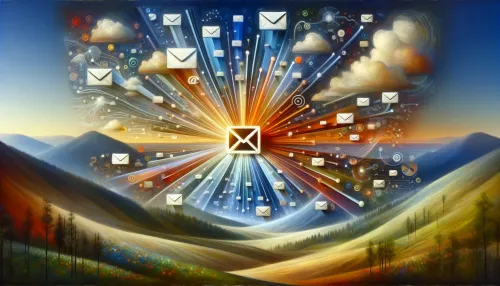Mastering Email Segmentation: How to Boost Engagement and Conversions

Understanding the Basics of Email Segmentation
Email segmentation is a critical component of any successful digital marketing strategy, allowing businesses to deliver targeted and relevant content to specific segments of their audience. At its core, email segmentation involves categorizing subscribers based on defined criteria such as demographics, behavior, or engagement level. This approach enables marketers to tailor their messages, resulting in improved engagement and higher conversion rates.
Segmentation provides a more personalized experience for subscribers, enhancing their overall satisfaction with the brand and its communication. By harnessing the power of email segmentation, marketers can strategically deliver content that resonates with individual preferences, ultimately driving stronger connections with their audience.
Personalization Techniques for Targeted Campaigns
Personalization lies at the heart of effective email segmentation. It goes beyond simply addressing subscribers by their first names; it involves crafting content that speaks directly to their interests, challenges, and aspirations. Leveraging personalization tokens in email campaigns allows marketers to dynamically insert subscriber-specific information into their messages, creating a customized experience for each recipient.
Furthermore, understanding the subscriber's past interactions with the brand can inform personalized recommendations and tailored content. Whether it's referencing previous purchases, browsing history, or specific interactions with previous emails, personalization techniques elevate the relevance of email content, capturing the attention of recipients and fostering a sense of uniqueness in each communication.
Related Article: From Data to Personalization: Harnessing Predictive Analytics in Email Marketing Campaigns
Segmenting Based on Customer Behavior and Interests
Segmenting subscribers based on their behavior and interests is a powerful method for refining targeted campaigns. By analyzing how subscribers engage with previous emails—whether they open, click through, or convert—marketers can gain valuable insights into their preferences and inclinations. This data serves as a foundation for creating segments that align with specific engagement patterns, ensuring that future communications are better tailored to individual interests.
Additionally, incorporating demographic information such as age, location, or industry can further enhance segmentation efforts. This strategic blend of behavioral and demographic segmentation allows marketers to build nuanced audience groups that reflect both engagement patterns and contextual characteristics.
Optimizing Automated Workflows for Enhanced Segmentation
Automation plays a pivotal role in scaling and sustaining effective email segmentation strategies. By harnessing marketing automation platforms, marketers can streamline the process of segmenting and targeting specific subsets of their audience. These platforms offer robust features such as conditional triggers and dynamic content based on subscriber attributes, enabling the creation of highly personalized automated workflows.
Moreover, utilizing machine learning algorithms for predictive segmentation can accurately anticipate subscriber behaviors and preferences, empowering marketers to proactively tailor their content to align with anticipated needs. The seamless integration of automation and predictive analytics amplifies the precision and efficacy of segmented email campaigns.
Converting Leads into Customers with Segmented Email Content
The prowess of segmented email content extends beyond engagement; it directly influences the conversion journey of leads into customers. Through strategic segmentation strategies, marketers can craft tailored narratives that guide leads through the sales funnel with relevant messaging at each stage. Whether it's introducing new prospects to the brand or nurturing existing leads through personalized offerings, segmented email content accelerates the conversion process by fostering meaningful connections based on individual needs and interests.
Furthermore, leveraging dynamic product recommendations within email content based on customer segmentation enhances cross-selling and upselling opportunities. Tailoring promotional offers and product suggestions according to segmented groups augments the likelihood of converting leads into loyal customers by providing them with compelling incentives aligned with their preferences.
Measuring Success: Analyzing Results and Refining Segmentation Strategies
Effective email segmentation is an iterative process that necessitates continual analysis and refinement. Marketers must actively monitor key performance indicators (KPIs) related to segmented email campaigns such as open rates, click-through rates, conversion rates, and revenue generated per segment. By scrutinizing these metrics, marketers gain insights into the effectiveness of their segmentation strategies and identify areas for optimization.
A diligent examination of results enables marketers to iterate upon their segmentation tactics by refining segment criteria, adjusting personalized content strategies, or reevaluating automated workflows. This adaptive approach ensures that segmented email campaigns remain dynamic and responsive to evolving subscriber behaviors, preferences, and market dynamics.
In conclusion, mastering email segmentation empowers marketers to deliver hyper-relevant content that resonates with each subscriber's unique characteristics and engagement history. By understanding the basics of segmentation, implementing personalization techniques, refining segment criteria based on behavior and interests, optimizing automated workflows, converting leads into customers with segmented content, and continually analyzing results for refinement marketers can drive enhanced engagement and conversions through meticulously crafted segmented email campaigns.
Check Out These Related Articles

The Resurgence of Email Marketing: Micro Personalization Tactics

Revolutionary Email Marketing: AI-Driven Innovations and Hyper-Personalization Strategies

Email Marketing Endurance: Debunking the Myth of Its Decline in the Face of Modern Channels

